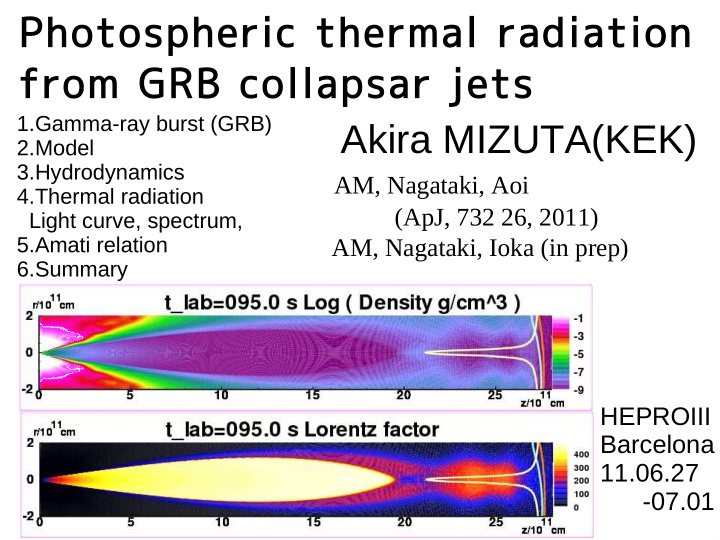



Photospheric thermal radiation from GRB collapsar jets 1.Gamma-ray burst (GRB) Akira MIZUTA(KEK) 2.Model 3.Hydrodynamics AM, Nagataki, Aoi 4.Thermal radiation (ApJ, 732 26, 2011) Light curve, spectrum, 5.Amati relation AM, Nagataki, Ioka (in prep) 6.Summary HEPROIII Barcelona 11.06.27 -07.01
Long GRB-SN connection Spectrum :after a few days ~ after a month from the burst Association long duration GRB-SN is observed. power law ex. GRB980425/SN1998bw, : afterglow GRB030329/SN2003dh XRF060218/SN2006aj. GRB091127/SN2009nz XRF100316D/SN2010bh The explosion energy of most SN-GRB time is 10 times higher than that of normal Sne (HyprenovaeE=10 52 erg) Explosion energy SN component appears Mazzali et al. (2006) λ(A) Progenitor mass
Spectrum of GRB prompt emission Band function: Broken power-law α~-1 Band function Band et al.(1993) β~ -2.3 ν -0.5 GRB090902B Ryde et al (2010) ν thermal component was ν 3 found. Plankian How can the photospheric thermal radiation be seen ? Briggs et al. (1999) light curve, spectrum Non-thermal radiation is expected. viewing angle effect There is no theoretical model --jet like explosion to explain the index for low energy band.
Method : Hydrodynamics Model Radial mass profile Progenitor: Model 16TI Woosley & Heger (2006) Log ρ Progenitor 14 solar mass at pre-SN stage. surface Radius: 4x10 10 cm Outside progenitor: Very low density ∝ ∝ Wind like distribution ρ r -2 wind ρ r -2 very low density : optically thin Computational Domain : 2D (r x θ) 1.e12 1.e11 1.e9 1.e10 spherical (10 9 cm<r<3x10 13 cm r (cm) 0<θ<π/2) (c.f. jet formation ~10^7cm Jet : t [0:100s] equatorial plane symmetry Power: 5.5x10 50 erg/s 2D-relativistic hydrodynamic Lorentz factor :Γ0 = 5 code(constant specific heat ratio=4/3) specific internal energy : approximate Riemann solver, ε0/c 2 =80 2 nd order accuracy in space & time half opening angle : θ0= 10/ 5 Mizuta et al. (2004,2006) degrees
movie
Shock-break log10(ρ/cm^3) Interaction between jet and progenitor Backflow envelopes. High pressure cocoon confinement and a bent backflow enhance the appearance Γ of internal oblique shocks. The jet includes knotty structure. internal shocks AM, Kino, Nagakura('10)
After shock-break I log10(ρ/cm^3) r~10^11cm progenitor Jet propagation ~c Expansion of cocoon, and shocked envelopes ~c_s(~0.5c) Expanding cocoon Expanding envelopes The head of the jet is Relaxed. Lateral Expansion is observed. Γ The density and Pressure of the Expanding envelopes Decrease, as time goes jet on. Free expansion is possible for the jets injected later.
After shock-break II log10(ρ/cm^3) r~10^12 cm Maximum Lorentz factor appears in the free expansion region ~500 (=Γ0*h0=533) Γ Hot Bubble dissipated Recollimation shock Cold Bullet free expansion no dissiparion
Method : Thermal Radiation from the jet. Step1. Remapping 2D hydor-data into 3D box using the assumption of axisymmetry Step2. Assuming the observer is at infinity, prepare a screen outside the computational box and consider photon rays perpendicular to the screen Step.3 calculate the optical depth along the photon rays until τ becomes unity where is the photo-sphere for Thomson scattering. (Abramowicz et al.1991) 1/beaming factor ~ 1/Γ (for β // n: LOS) is unit vector which is parallel to LOS n : electron number density 2 ρ/m_He Step4. Calculate the blackbody luminosity for each elements And integrate them (τ =1 ) T is the local temperature derived from p=aT 4 /3
Mass density, Lorentz log10(ρ) log10(ρ) factor, and photosphere contours. Γ Γ Since the denisty is low And the beaming factor ~c Is high near the jet axis, The photospere is quite Concave shape. Γ The arrival time of the Radiation from inner log10(ρ) Photosphre to the observer Is expected to delay in the light curve Γ
Duration of light curve ~ Light curve jet injection. A few seconds time variability In early phase caused by Internal discontinuity in the jet. Dissipated region Free expanding region Morsony et al..’07 Lazzati et al.‘11
Spectrum Constructed by superposition of Up-scattering via Plankian (local temp.) Inverse Compton boosted by beaming Is necessary factor δ (relativistic effect) Peak energy shifts to low energy band, as the observer moves to off-axis. Multicolor contribution Rayleigh-Jeans tail can be applied to explain this property GRB090926B? cf. multicolor model applied to accretion disk model
The length of both cold θ0=10degrees bullet and hot bubble Γ does not change so Much at the scale of 10 12-13 cm Cold Bullet dissipated (hot bubble) free expandion region length/c ~ bright phase in light curve θ0=5degrees Cold bullet should Γ be short for larger radiative efficiency. Cold Bullet Stray bullet problem? free expansion
OA10 ε0,Γ0,dE/dt constant 4 times dense model θ0=10 defrees top θ0=5 2degrees bottom OA05
Amati Relation (Amati 2002,2006) 05 θv small Lazzati et al. ‘11 ApJ submitted Lazzati et al. (2011) also observes same trend
Conclusion ●Light curves and spectrum of photospheric thermal radiation is derived from numerical hydrodynamic simulations of relativistic jets from collapsars. ●Isotropic luminosity is comparable to GRB prompt emission. time variability in a few seconds is observed. ●spectrum has a peak energy and spectrum power law index is much softer than that of single temperature single Plank distribution, i.e., “multi-colored”. The index is comparable for off-axis cases and 2.0-2.5 for on-axis case (θv~0-2 degrees). ● We observed “numerical” Amati relation relation. It is interesting to extend jet parameters and to develop theoretical models.
Recommend
More recommend